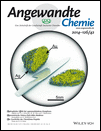Tailoring Intermolecular Interactions for Efficient Room-Temperature Phosphorescence from Purely Organic Materials in Amorphous Polymer Matrices†
This research was partly supported by a Samsung GRO grant. D.L. was partly supported by a fellowship from LG Chemicals.
Abstract
Herein we report a rational design strategy for tailoring intermolecular interactions to enhance room-temperature phosphorescence from purely organic materials in amorphous matrices at ambient conditions. The built-in strong halogen and hydrogen bonding between the newly developed phosphor G1 and the poly(vinyl alcohol) (PVA) matrix efficiently suppresses vibrational dissipation and thus enables bright room-temperature phosphorescence (RTP) with quantum yields reaching 24 %. Furthermore, we found that modulation of the strength of halogen and hydrogen bonding in the G1–PVA system by water molecules produced unique reversible phosphorescence-to-fluorescence switching behavior. This unique system can be utilized as a ratiometric water sensor.




